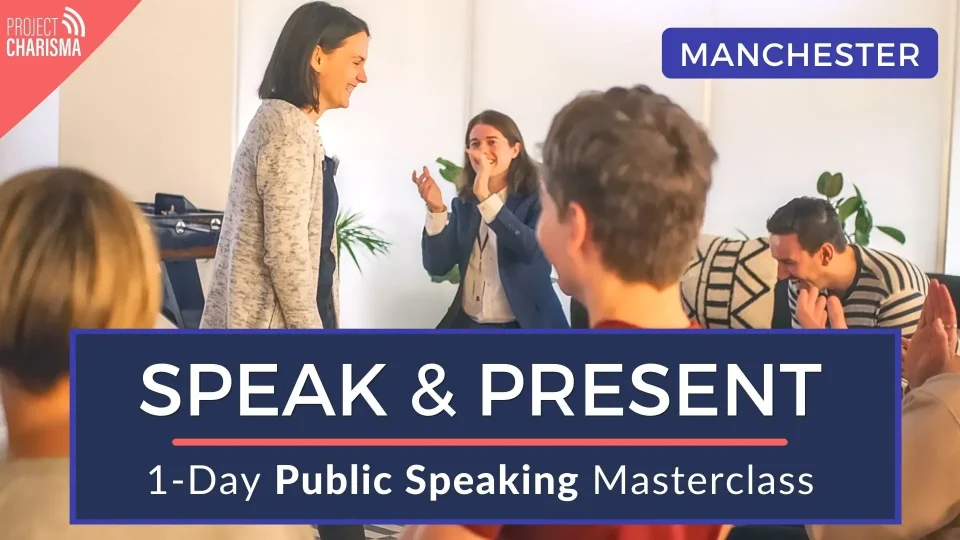10 Quick Tips to Overcome Public Speaking Anxiety

Ed Darling
9 min read
What you’ll learn:
- Practical tips for lowering public speaking anxiety
- An actor’s technique for feeling calm on stage
- How to shift your perspective on public speaking

A Quick Preface On Public Speaking Anxiety
It’s often said more people fear public speaking than death — with studies suggesting up to 75% of people experience anxiety when speaking. Also known as glossophobia, it’s a common fear ranging from mild nervousness to severe panic.
Throughout my 20s, I struggled with both social anxiety and glossophobia, which turned public speaking into my worst nightmare!
In my experience, the best solution is professional training: developing your skills and confidence within a supportive, low-pressure environment. It’s how I help my clients to transform their fears into confidence.
With that said, this article focuses on quick tips to reduce your public speaking anxiety in the short term.
If you have a last-minute speech or an impending presentation, I’ll do my best to help you succeed!
1. Reduce Your 'Audience Fear' by Chatting Beforehand
One of the worst things anxious speakers can do before a presentation is to isolate themselves. Instead, spend the hours before your speech chatting, socialising, and talking with people.
If you’re speaking at an event, introduce yourself to the organisers, other speakers, and even members of the audience. This’ll help you feel more connected, give you some useful audience insights, and crucially — keep you from overthinking!
Don’t hide away trying to memorise notes or shout affirmations at yourself. The more people you speak with beforehand, the less daunting it will feel to address the entire room.
It’s fine to take a few minutes to centre yourself, but generally, staying present and being social is the best pre-talk strategy for nerves.
2. Make the Stage 'Known Territory'
As an actor, I always made a point of walking around the stage before a performance. This allowed me to gauge the space, get a feel for the venue, and visualize the theatre filled with people.
Doing this transforms the stage from “unfamiliar and daunting” to “known territory.”
I follow the same habit whenever I’m speaking. Whether it’s an auditorium or a training room, I arrive early to walk around the space and familiarise myself with it.
If time allows, I’ll walk through my opening lines or practice a few sections. For virtual presentations, log in early, check your technology, and ensure everything is set up correctly.
Stepping on stage can be daunting, but if you’ve already spent time in the space, it’s less intimidating when your audience is seated.
3. Memorize Your Introduction for a Confident Start
The first minute of a speech is often the most challenging. Your adrenaline is at its peak, and your audience is forming their first impressions.
A strong start can help you settle into the rest of your speech, while a shaky beginning can make it hard to regain confidence.
One of the best public speaking anxiety tips is to guarantee a strong start by memorising your introduction. Write out your opening sentences, rehearse your delivery out loud, and repeat this process until it’s fully committed to memory.
For instance, write down your first 3–5 sentences, record yourself saying them, and listen back to ensure you sound natural and confident. Practice in front of a mirror or with a friend for feedback.
The more you rehearse, the deeper the ‘mental groove’ you form. Eventually, your delivery becomes so ingrained that, regardless of your anxiety levels, it’s almost impossible to go off-track.
Quick note: If your delivery feels “wooden,” you haven’t rehearsed enough. Keep practicing until it flows naturally and feels spontaneous!
Ready to speak with confidence?
Explore our training options...
4. Use Audience Interaction to Reduce Your Anxiety
For severely anxious speakers, having a room full of people staring at you can be overwhelming.
Instead of letting the anxiety build, relieve the pressure by incorporating audience interaction.
This could include:
- Asking a specific question
- Calling for a show of hands
- Instructing people to discuss in groups
- Posing a rhetorical question
- Showing an image or video
For example, you might start with, “Has anyone here faced a similar challenge?” or “Let’s see a show of hands for those who agree with this point.”
These interactions not only engage the audience but also give you a moment to breathe and reset.
Planning some audience interaction throughout your presentation can help manage severe public speaking anxiety. Sometimes, just knowing that you have a “breather” coming up can calm your nerves!
5. Focus on Speaking to Give, Not Speaking to Get
A major source of anxiety in public speaking comes from focusing on what you need from the audience: praise, approval, or acceptance.
This puts you in a disempowered position, worrying about whether you’ll get the outcome you want.
In contrast, the best speakers focus on what they can give: insights, ideas, or emotions.
This shift in perspective puts you in a position of power, helping you stay calm and present.
Remember, your audience is there to learn from you.
Think about how your message can benefit them — whether it’s providing new information, inspiring them, or helping them solve a problem. This focus on giving value can reduce your public speaking anxiety by taking the spotlight off yourself.
6. Have Water on Hand!
If you’re speaking for more than a few minutes, always have water nearby. A dry mouth can be distracting and uncomfortable (believe me, I’ve been there at the start of a 20-minute speech with my mouth already parched!)
Avoid large glasses or hot drinks that you might spill. A standard bottle of water is best. Place it somewhere you can reach easily, or even keep it in your back pocket if the stage is large.
For extra points: Time your sip after a rhetorical question or visual slide, where you would naturally pause anyway. This can serve as a natural break to compose yourself.
7. Let Your Body Use the Adrenaline
Most physical symptoms of public speaking anxiety, like shaky legs or a racing heart, are caused by adrenaline. Instead of letting this energy overwhelm you, harness it for your performance.
Move around the stage, use gestures, and project your voice. Channel that nervous energy into your delivery, making your presentation more dynamic and engaging.
This is especially useful on a stage where you have room to move. If you’re sitting down, focus on other techniques like diaphragmatic breathing.
9. Share the Limelight with Impactful Slides
If you’re uncomfortable being the sole focus, let your slides share some of the attention!
Well-designed slides can draw the audience’s gaze, giving you a moment to relax while still delivering your message.
Create slides with high-quality images, minimal text, and key points that complement your speech. For example, use a slide with a relevant quote or statistic to support your message.
You can also incorporate short videos or props for added engagement, which can ease your nerves by shifting some of the focus away from you.
10. Pause Your Public Speaking Anxiety
Speaking too fast is a common sign of nervousness. Adrenaline can make you feel like you’re on fast-forward, which can confuse your audience and make you more anxious.
The solution is to embrace the power of pausing.
Don’t just pause momentarily to catch your breath; take deliberate pauses of 3–5 seconds after key points. This allows you to collect your thoughts and lets the audience absorb what you’ve said.
Start by pausing before you begin your speech and after your first sentence. This sets a calm pace from the beginning, making it less likely you’ll rush through the rest.
My Best Advice For Public Speaking Anxiety...
Public speaking anxiety is a common challenge, but it’s one that can be completely overcome with the right strategies and training (I can say this with confidence, because I’ve been there myself.)
While these tips can help you in the short term, the long-term goal is to remove that overwhelming anxiety response, and learn to enjoy your moment in the spotlight
We do this through skill development, regular practise within a low-pressure environment, and consistently leaning in to the challenge rather than avoiding it.
If you’re interested to learn more about our training, feel free to get in touch.
Remember, public speaking anxiety isn’t a life sentence. It’s something which you can absolutely overcome!
To speaking with confidence,
Ed

